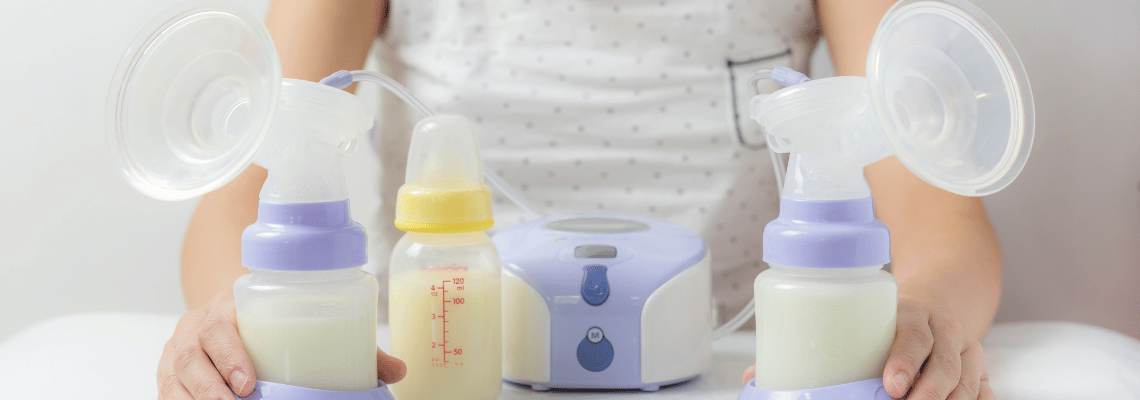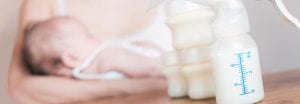
Mothers have many reasons to utilize breast pumping to keep their babies well-fed. Some mothers are separated from their hospitalized babies and need their newborns to continue benefiting from breast milk while they are apart. Other women must return to the office, or desire more flexibility and convenience in their busy lifestyles while still being able to provide breast milk to their babies.
Not only does breast pumping help a mother to keep her baby supplied with breast milk, but it can also help her maintain her milk production, relieve engorgement and build a supply of breast milk for storage.
When Should You Start Breast Pumping?
You can begin breast pumping when you feel it makes sense to you. Each woman’s specific situation determines the right time for her. A new mother can start pumping right after the birth of her baby to enhance her milk supply or help initiate breastfeeding. The pump can be particularly essential for mothers who have challenges nursing their babies, for example, when a baby is born prematurely or has special needs.
Some new mothers may wait a few weeks to pump, until they have established breastfeeding, the recommended way to feed the baby. In this situation, mothers can start pumping the extra milk between nursing sessions and store it for later feedings. It’s important to note that moms planning to resume their jobs need to begin the pumping process two to three weeks ahead of time to get used to it and to create a large enough stock of breast milk.
How Often and How Much to Pump
The number of times to pump daily will depend on whether you are primarily breastfeeding or exclusively pumping. Breastfeeding moms should pump in the morning when their milk is most likely to be in high supply. They can also pump 30 to 60 minutes after breastfeeding or one hour before to ensure the baby has enough breast milk for its next feeding.
 Exclusive pumping requires mothers to use the pump 8 to 10 times daily to promote full milk production. When exclusively pumping, you can expect milk production to be around 25 to 35 ounces (750 to 1,035 milliliters) every 24 hours. After reaching full milk production, it is helpful to keep a schedule that ensures you pump about the same quantity or more each 24 hours.
Exclusive pumping requires mothers to use the pump 8 to 10 times daily to promote full milk production. When exclusively pumping, you can expect milk production to be around 25 to 35 ounces (750 to 1,035 milliliters) every 24 hours. After reaching full milk production, it is helpful to keep a schedule that ensures you pump about the same quantity or more each 24 hours.
Remember, every mom and baby have different needs, which change as the baby grows. So be sure to schedule your breast-pumping sessions to fit your changing needs. For instance, you may need to increase the number or duration of your pumping sessions to have more supply as the baby grows.
Common Pumping Problems and Tips
Following are some common pumping problems and solutions, along with some best-practice tips.
Pumping too quickly can make your breasts sore and discourage you from finishing the pumping session. So, be sure to pump at a comfortable pace, and don’t rush through it. Remember to pump for at least 10 minutes at a time.
Pumping too often, for too long or not enough can also cause soreness. If your breasts are never fully emptied, they can grow engorged with milk, causing discomfort. If you need more than one pumping session daily, keep each session to 90 minutes or less.
Not emptying the breast while pumping can also prevent ideal oxytocin stimulation of the uterus. So, try to pump until you can express only a few drops from each nipple. At that point, it is beneficial to continue pumping until you are only able to obtain 30 milliliters of milk or less from each breast.
How to Ensure Your Pumped Breast Milk is Safely Stored
Pumped breast milk should be put in storage bags specifically made for breast milk before transferring them to storage. You can also use BPA-free containers made of glass or plastic with proper lids for effective sealing.
The guidelines for storing pumped breast milk include the following:
- Breast milk can be kept at room temperature, but don’t leave it out for more than four hours. Moreover, the temperature of the room should be 77 degrees Fahrenheit or less.
- You should not keep breast milk in the refrigerator for more than four days.
- Ideally, breast milk should be stored in the freezer for six months or less, but you can extend the time to 12 months maximum if need be.
- Avoid storing breast milk in the refrigerator or freezer door, since the temperature fluctuation as you move items in and out of the refrigerator or freezer will affect the milk.
- If you don’t plan to use freshly pumped milk within four days, freeze the milk immediately.
- Freeze milk in small quantities that the baby can take in one feeding.
- Leave an inch of free space at the top of your storage bag since breast milk expands when freezing.
- Label the milk indicating the date it was expressed.
How to Care for Your Breast Pump
Taking care of your breast pump reduces the chance of causing health issues for your baby. Before assembling the pump, wash your hands well with soap and ensure the pump is clean before pumping. Discard the pump and replace it immediately if you notice any mold in the tubing.
Here are some care tips to consider when cleaning your pump after use:
- Rinse all parts of the pump that were in contact with the breast or milk.
- Dip the parts of the pump that were in contact with the breast or milk in hot soapy water and clean thoroughly using a bowl set aside for this work.
- Use a different bowl to rinse the items in hot water and air dry the pump kit.
- If the manufacturer of your pump recommends it, you can boil or sanitize the parts that come into contact with the milk or breast each day.
Ultimately, the key to breast pumping success is scheduling time to pump regularly. If you have any problem pumping or have additional questions after reading this guide, the best advice we can provide is to talk to your doctor or lactation consultant. We wish you all the best in your breastfeeding journey!


